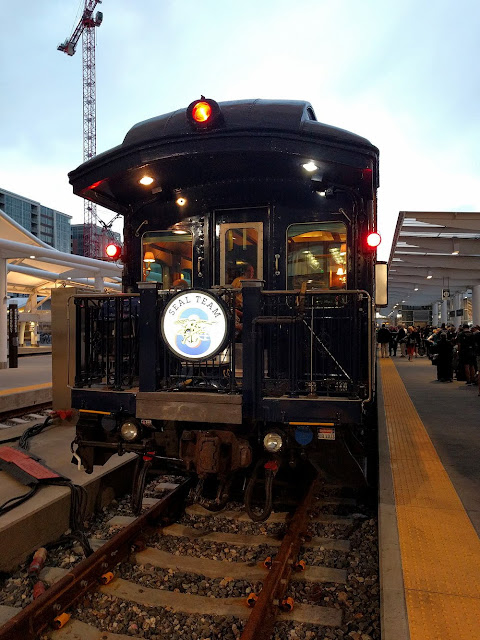Today CP-WING consists of a 3-track full crossover with an extra yard lead on the east end. The northern two tracks belong to the NS Pittsburgh Line while the southern track runs out of Pitcarin Yard and straight through to become the Port Perry branch. This line bypasses downtown Pittsburgh along the southern banks of the Monongahela River. The interlocking features a full 3-track PRR signal bridge at the west end and two PRR position light masts on the main tracks along with a Unilens Dwarf and a target type color light mast for the yard tracks at the east end. All the switches are still pneumatically operated. If you are interested in the full set of photos, they can be found here.
So as I rolled up in the car I had to scramble to capture NS C44-9W #9945 and a 27xx series SD70ACe leading an eastbound doublestack trains past the westbound mast signals at CP-WING. This is a popular railfan location due to the ease of access and interesting background items.
WING tower was replaced by this double-wide relay hut in a ~1970's CTC project between CP-CONPIT and CP-HOME. Note the air line running out to supply the pneumatic switches.
The air compressor was located in this classic structure that pre-dated the CTC project. When I arrived at the site I found two people who appeared to be railroad workers in NS style high visibility yellow safety vests. After making some small talk I soon realized that they were actually municipal utility workers using their official vehicle to harvest scrap metal from the right of way. This sums up the situation for your Simpsons fans out there ;-)
It's such a shame that non-solid state technologies are becoming so rare these days. Here we see the air plant outside the compressor house at CP-WING. Although the pneumatic point machines here are likely to be retired in the near future, NS had to fabricate some new housings for the mechanisms since US&S stopped supporting the product around 10-15 years ago.
Shortly thereafter another eastbound doublestack train appeared off the Port Perry branch, crossing over to Pittsburgh Line track #1. NS ES44AC #8131 was in the head with C44-9W #9325 running behind.
Shortly thereafter an NS "helper pack" of two SD40E's (rebuilt SD50's #6332 and #6310) that had been waiting for the stack train to clear up, got it's signal and proceeded eastbound behind it. With the popularity of distributed power arrangements out west, the PRR main line is probably the most active helper districts left in the United States with pairs of SD40E's helping trains get up and down the Allegheny summit between Altoona and various points between Johnstown and Pittsburgh.
After a few minutes observing the local wildlife, a westbound showed up, passing under the classic PRR signal bridge with NS C44-9W #9904 and #9875 in the lead.
A fourth westbound movement soon materialized with another NS C44-9W (yawn) on point, but a significantly more interesting standard cab SD70 #2532, following behind.

























































